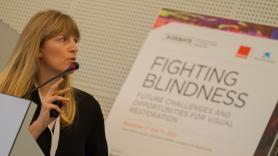Nearly 300 million people have serious vision problems, and an estimated one in five people in the world go blind every five seconds. There are many causes of blindness, ranging from such different illnesses as age-related macular degeneration and glaucoma to others that are hereditary, like retinitis pigmentosa and Stargardt disease. Although procedures to slow onset have been developed for some of them, many currently have no effective treatment.
Now, hopes are pinned on multidisciplinary, possibly complementary, studies: more in-depth knowledge of the genes and mechanisms behind blindness, drug cocktails, gene therapy, optogenetics and stem-cell transplants. According to Jordi Monés, director of the Barcelona Macula Foundation, “We are starting down a long, hard road but it will be an exciting trip.”
To share and discuss the main news in all of these fields, national and international experts met for a session of B·Debate, an initiative of Biocat and the “la Caixa” Foundation to promote scientific debate. The debate, entitled Fighting Blindness. Future Challenges and Opportunities for Visual Restorationwas co-organized by the Barcelona Macula Foundation with collaboration from the Center for Genomic Regulation (CRG) and LEITAT.
CONCLUSIONS
- The main cause of blindness in developed countries is Age-related Macular Degeneration (AMD). One of its two forms has no treatment and with the other there can be issues of resistance, which scientists are studying how to overcome.
- The battery of studies includes fields like optogenetics, nanotechnology and visual prosthetics, which so far have only yielded partial results.
- Gene therapy is one of the greatest hopes in fighting visual defects, especially hereditary ones. Scientists are working to make them more effective and safer.
- Regenerative therapy with stem cells is the main hope for very advanced cases. There are currently many studies underway with stem cells to treat different types of blindness.The future will surely be a combination of several therapies.



